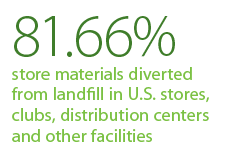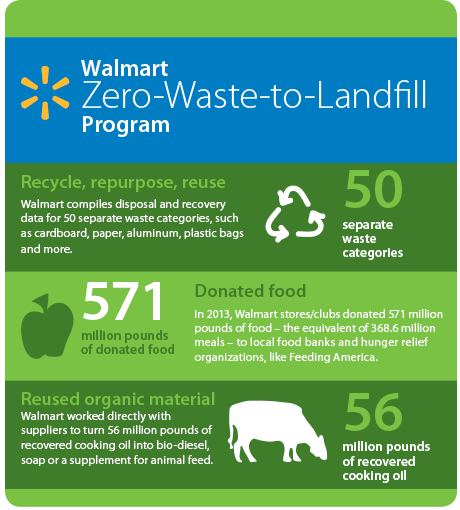Environment
Targeting zero waste
In 2005, Walmart took on three aspirational goals that encompass all areas of our operations and products – energy, waste and sustainable products. Since those goals were communicated, we’ve aggressively worked to address waste in our own operations as well as in the products we sell and associated packaging. In the U.S. specifically, we’re committed to reaching zero waste to landfill by 2025 for our own operations. In terms of waste, we take a two-pronged approach:
- Diversion: We identify the best opportunities to reuse or recycle each material.
- Reduction: We identify opportunities to prevent materials from entering the recycle, reuse or waste stream in the first place.

Operation waste diversion
Today, we’re diverting 81.66 percent of the materials that flow through our U.S. stores, clubs, distribution centers and other facilities. We continue to make improvements by providing more accurate and timely reporting to our associates in the field, and by finding better diversion options for groups of facilities.
While we continue to look for ways to divert materials to a higher and better use, we’ve also successfully worked with our suppliers and vendors to prevent many materials from becoming part of the waste or recycling stream. Total annual waste generated from operations in the U.S. (diverted and nondiverted) has decreased by 3.3 percent, compared to our 2010 baseline.
Our goal of achieving zero waste motivates associates and suppliers across our global operations, and we continue to make measurable progress every day. For instance, our operations in Japan and U.K. are now diverting from landfill more than 90 percent of the materials that used to be characterized as waste. Walmart Canada and Walmart Mexico are diverting more than 70 percent of their waste.

Food throwaway reduction
Walmart in Central America, Japan, Mexico and U.K. continues to drive significant progress toward food throwaway reduction. Walmart Brazil leveraged global best practices in 2013 to improve produce presentation, standardize operating procedures, align orders with sales and implement a storage guide to avoid produce waste. This helped Brazil reduce annual food waste by 1.7 million kilograms and improve customer experience.
Taking a broader view
While we’ve made significant progress since announcing our commitment to achieve zero waste, we’re now leveraging the successes and learnings along the way to take a more comprehensive value-chain view of our global waste program. By taking a more comprehensive approach – considering waste at all generation points along the life cycle of our products – we will begin to move forward in ways that were previously unimagined.
Globally, we’ve added depth to how and with whom we work within our markets. In addition to identifying associates who will lead these programs in each of our markets, we plan to enhance the people, processes and data that can be leveraged across all geographies. Together, these improvements will enable us to increase the speed, consistency and reach of our pursuit of zero waste globally.
While infrastructure and regulations vary greatly in the markets where we operate, the following represent the common drivers and challenges across our global operations:
Drivers
- Information: Organized measurement, tracking and reporting tools, and processes; working toward being able to report our global waste diversion in the future
- Champions: Associates who actively promote and execute diversion programs at the facility and market level
- Efficiency: Leverage the use of our own infrastructure and resources at scale
- Paradigm shift: Change mindset from the handling of waste to the management of commodities
Challenges
- Infrastructure: Lack of recycling infrastructure in multiple markets
- Partners: Finding companies who can meet our needs for equipment, processes and data, and who can provide effective solutions for the broad range of commodities that flow through our facilities
- Legislation and regulation: Wide-ranging legislation and regulation that varies from region to region, even within markets
- Widely dispersed base of stores: Transportation becomes challenging
